roof SAAB 9-5 2003 User Guide
[x] Cancel search | Manufacturer: SAAB, Model Year: 2003, Model line: 9-5, Model: SAAB 9-5 2003Pages: 288, PDF Size: 16.78 MB
Page 185 of 288
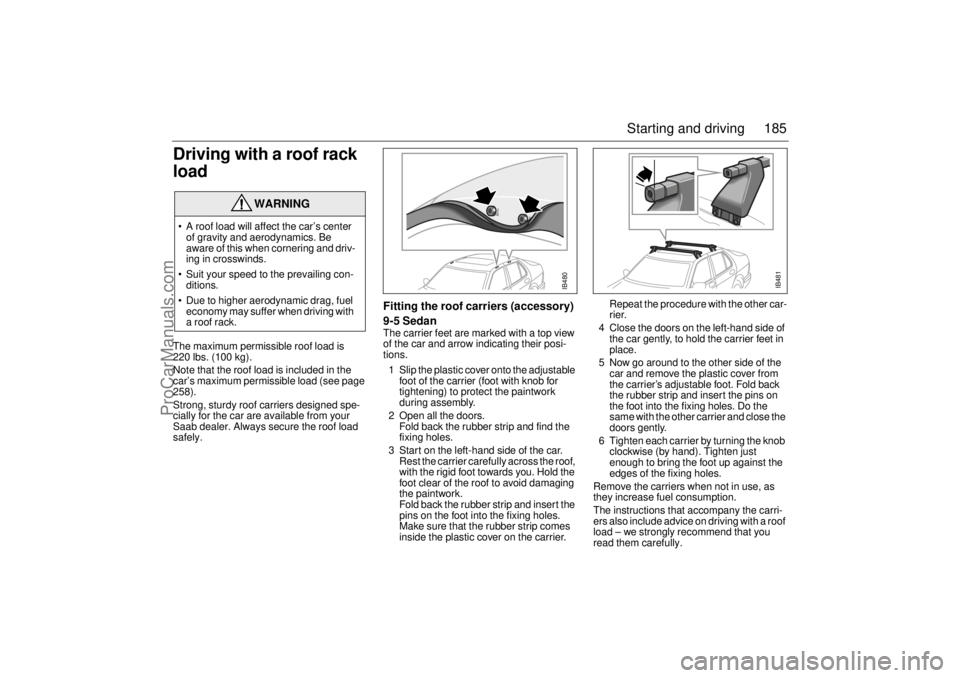
185 Starting and driving
Driving with a roof rack
loadThe maximum permissible roof load is
220 lbs. (100 kg).
Note that the roof load is included in the
car’s maximum permissible load (see page
258).
Strong, sturdy roof carriers designed spe-
cially for the car are available from your
Saab dealer. Always secure the roof load
safely.
Fitting the roof carriers (accessory)
9-5 SedanThe carrier feet are marked with a top view
of the car and arrow indicating their posi-
tions.
1 Slip the plastic cover onto the adjustable
foot of the carrier (foot with knob for
tightening) to protect the paintwork
during assembly.
2 Open all the doors.
Fold back the rubber strip and find the
fixing holes.
3 Start on the left-hand side of the car.
Rest the carrier carefully across the roof,
with the rigid foot towards you. Hold the
foot clear of the roof to avoid damaging
the paintwork.
Fold back the rubber strip and insert the
pins on the foot into the fixing holes.
Make sure that the rubber strip comes
inside the plastic cover on the carrier. Repeat the procedure with the other car-
rier.
4 Close the doors on the left-hand side of
the car gently, to hold the carrier feet in
place.
5 Now go around to the other side of the
car and remove the plastic cover from
the carrier’s adjustable foot. Fold back
the rubber strip and insert the pins on
the foot into the fixing holes. Do the
same with the other carrier and close the
doors gently.
6 Tighten each carrier by turning the knob
clockwise (by hand). Tighten just
enough to bring the foot up against the
edges of the fixing holes.
Remove the carriers when not in use, as
they increase fuel consumption.
The instructions that accompany the carri-
ers also include advice on driving with a roof
load – we strongly recommend that you
read them carefully.
WARNING
A roof load will affect the car’s center
of gravity and aerodynamics. Be
aware of this when cornering and driv-
ing in crosswinds.
Suit your speed to the prevailing con-
ditions.
Due to higher aerodynamic drag, fuel
economy may suffer when driving with
a roof rack.
IB480
IB481
ProCarManuals.com
Page 186 of 288
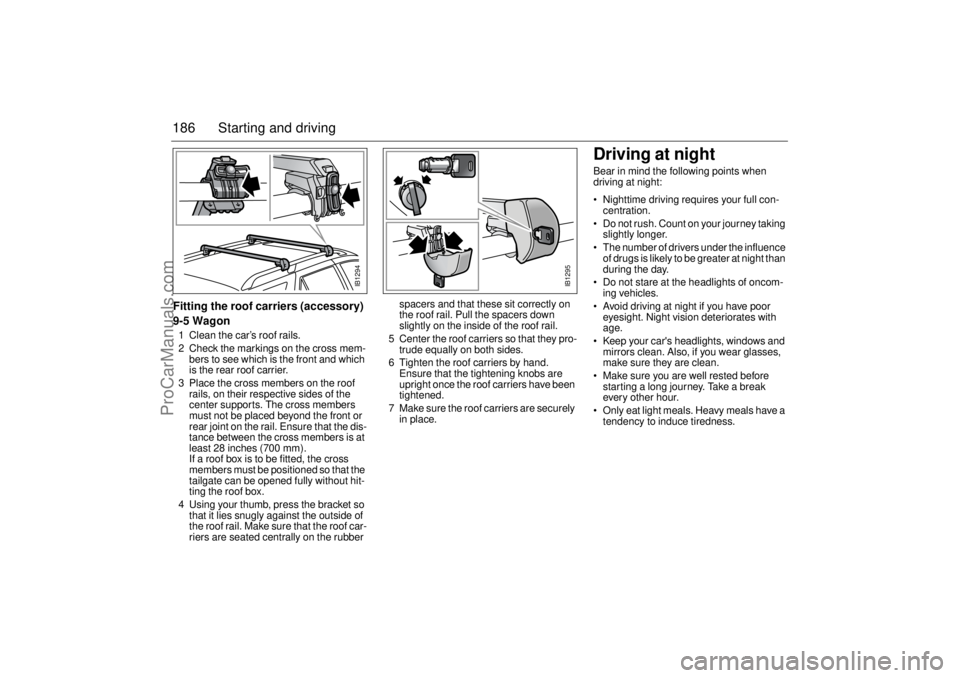
186 Starting and drivingFitting the roof carriers (accessory)
9-5 Wagon1 Clean the car’s roof rails.
2 Check the markings on the cross mem-
bers to see which is the front and which
is the rear roof carrier.
3 Place the cross members on the roof
rails, on their respective sides of the
center supports. The cross members
must not be placed beyond the front or
rear joint on the rail. Ensure that the dis-
tance between the cross members is at
least 28 inches (700 mm).
If a roof box is to be fitted, the cross
members must be positioned so that the
tailgate can be opened fully without hit-
ting the roof box.
4 Using your thumb, press the bracket so
that it lies snugly against the outside of
the roof rail. Make sure that the roof car-
riers are seated centrally on the rubber spacers and that these sit correctly on
the roof rail. Pull the spacers down
slightly on the inside of the roof rail.
5 Center the roof carriers so that they pro-
trude equally on both sides.
6 Tighten the roof carriers by hand.
Ensure that the tightening knobs are
upright once the roof carriers have been
tightened.
7 Make sure the roof carriers are securely
in place.
Driving at nightBear in mind the following points when
driving at night:
Nighttime driving requires your full con-
centration.
Do not rush. Count on your journey taking
slightly longer.
The number of drivers under the influence
of drugs is likely to be greater at night than
during the day.
Do not stare at the headlights of oncom-
ing vehicles.
Avoid driving at night if you have poor
eyesight. Night vision deteriorates with
age.
Keep your car's headlights, windows and
mirrors clean. Also, if you wear glasses,
make sure they are clean.
Make sure you are well rested before
starting a long journey. Take a break
every other hour.
Only eat light meals. Heavy meals have a
tendency to induce tiredness.
IB1294
IB1295
ProCarManuals.com
Page 187 of 288
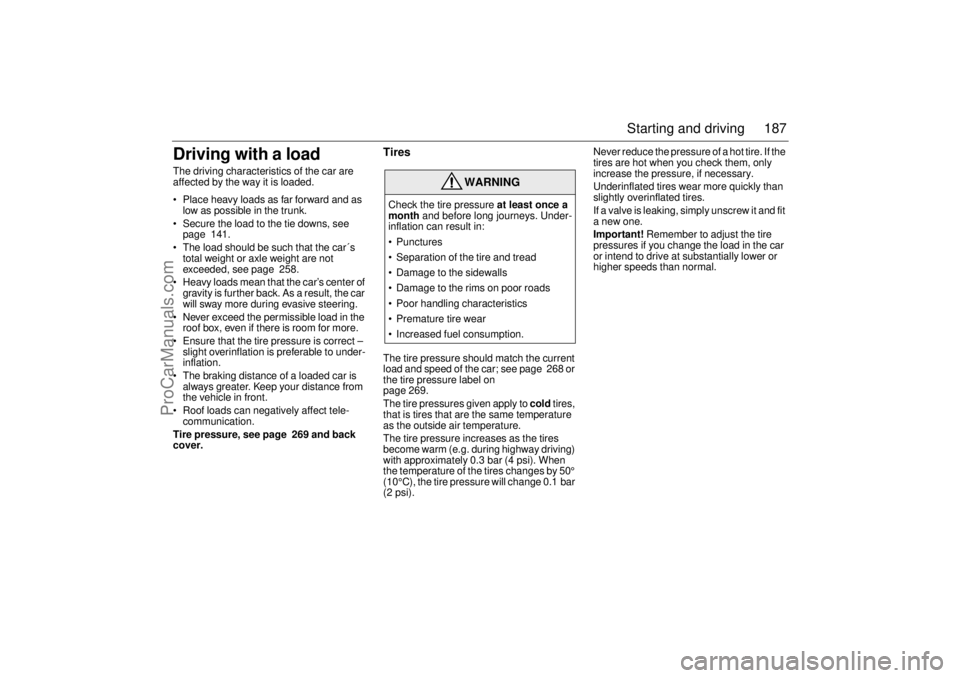
187 Starting and driving
Driving with a loadThe driving characteristics of the car are
affected by the way it is loaded.
Place heavy loads as far forward and as
low as possible in the trunk.
Secure the load to the tie downs, see
page 141.
The load should be such that the car´s
total weight or axle weight are not
exceeded, see page 258.
Heavy loads mean that the car’s center of
gravity is further back. As a result, the car
will sway more during evasive steering.
Never exceed the permissible load in the
roof box, even if there is room for more.
Ensure that the tire pressure is correct –
slight overinflation is preferable to under-
inflation.
The braking distance of a loaded car is
always greater. Keep your distance from
the vehicle in front.
Roof loads can negatively affect tele-
communication.
Tire pressure, see page 269 and back
cover.
Tires The tire pressure should match the current
load and speed of the car; see page 268 or
the tire pressure label on
page 269.
The tire pressures given apply to cold tires,
that is tires that are the same temperature
as the outside air temperature.
The tire pressure increases as the tires
become warm (e.g. during highway driving)
with approximately 0.3 bar (4 psi). When
the temperature of the tires changes by 50°
(10°C), the tire pressure will change 0.1 bar
(2 psi).Never reduce the pressure of a hot tire. If the
tires are hot when you check them, only
increase the pressure, if necessary.
Underinflated tires wear more quickly than
slightly overinflated tires.
If a valve is leaking, simply unscrew it and fit
a new one.
Important! Remember to adjust the tire
pressures if you change the load in the car
or intend to drive at substantially lower or
higher speeds than normal.
WARNING
Check the tire pressure at least once a
month and before long journeys. Under-
inflation can result in:
Punctures
Separation of the tire and tread
Damage to the sidewalls
Damage to the rims on poor roads
Poor handling characteristics
Premature tire wear
Increased fuel consumption.
ProCarManuals.com
Page 188 of 288
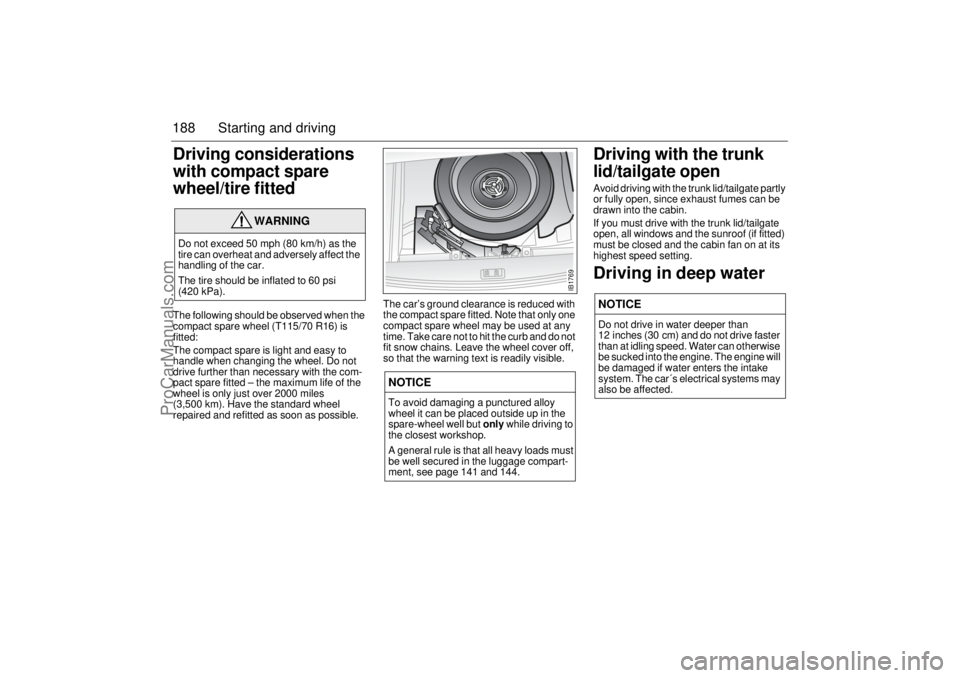
188 Starting and drivingDriving considerations
with compact spare
wheel/tire fittedThe following should be observed when the
compact spare wheel (T115/70 R16) is
fitted:
The compact spare is light and easy to
handle when changing the wheel. Do not
drive further than necessary with the com-
pact spare fitted – the maximum life of the
wheel is only just over 2000 miles
(3,500 km). Have the standard wheel
repaired and refitted as soon as possible. The car’s ground clearance is reduced with
the compact spare fitted. Note that only one
compact spare wheel may be used at any
time. Take care not to hit the curb and do not
fit snow chains. Leave the wheel cover off,
so that the warning text is readily visible.
Driving with the trunk
lid/tailgate openAvoid driving with the trunk lid/tailgate partly
or fully open, since exhaust fumes can be
drawn into the cabin.
If you must drive with the trunk lid/tailgate
open, all windows and the sunroof (if fitted)
must be closed and the cabin fan on at its
highest speed setting.Driving in deep water
WARNING
Do not exceed 50 mph (80 km/h) as the
tire can overheat and adversely affect the
handling of the car.
The tire should be inflated to 60 psi
(420 kPa).
NOTICETo avoid damaging a punctured alloy
wheel it can be placed outside up in the
spare-wheel well but only while driving to
the closest workshop.
A general rule is that all heavy loads must
be well secured in the luggage compart-
ment, see page 141 and 144.
NOTICEDo not drive in water deeper than
12 inches (30 cm) and do not drive faster
than at idling speed. Water can otherwise
be sucked into the engine. The engine will
be damaged if water enters the intake
system. The car´s electrical systems may
also be affected.
IB1769
ProCarManuals.com
Page 228 of 288
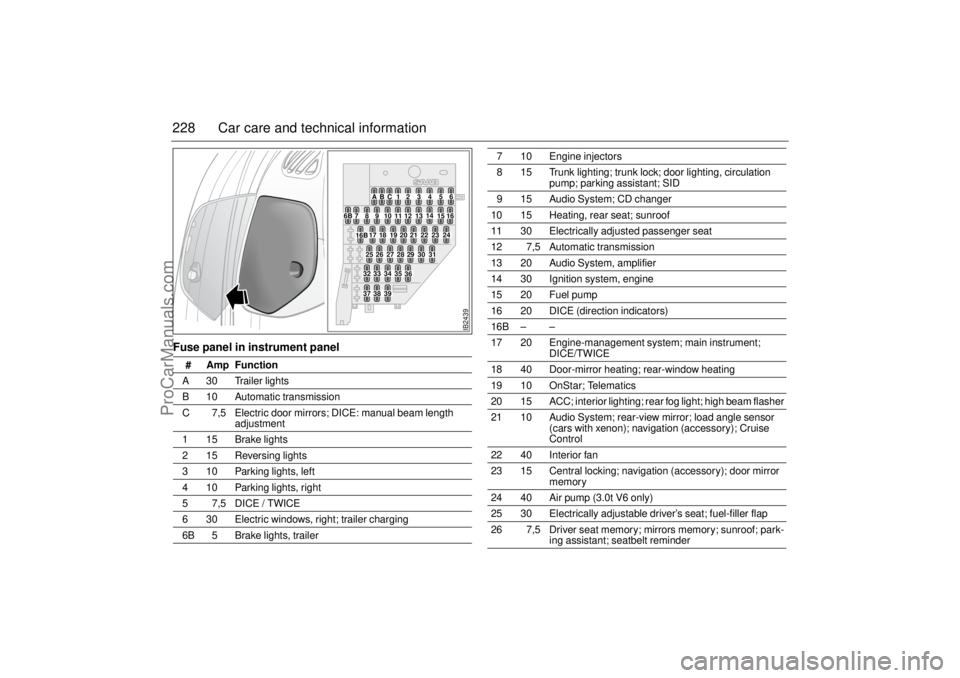
228 Car care and technical informationFuse panel in instrument panel
# Amp Function
A 30 Trailer lights
B 10 Automatic transmission
C 7,5 Electric door mirrors; DICE: manual beam length
adjustment
115Brake lights
2 15 Reversing lights
3 10 Parking lights, left
4 10 Parking lights, right
5 7,5 DICE / TWICE
6 30 Electric windows, right; trailer charging
6B 5 Brake lights, trailer
7 10 Engine injectors
8 15 Trunk lighting; trunk lock; door lighting, circulation
pump; parking assistant; SID
9 15 Audio System; CD changer
10 15 Heating, rear seat; sunroof
11 30 Electrically adjusted passenger seat
12 7,5 Automatic transmission
13 20 Audio System, amplifier
14 30 Ignition system, engine
15 20 Fuel pump
16 20 DICE (direction indicators)
16B – –
17 20 Engine-management system; main instrument;
DICE/TWICE
18 40 Door-mirror heating; rear-window heating
19 10 OnStar; Telematics
20 15 ACC; interior lighting; rear fog light; high beam flasher
21 10 Audio System; rear-view mirror; load angle sensor
(cars with xenon); navigation (accessory); Cruise
Control
22 40 Interior fan
23 15 Central locking; navigation (accessory); door mirror
memory
24 40 Air pump (3.0t V6 only)
25 30 Electrically adjustable driver’s seat; fuel-filler flap
26 7,5 Driver seat memory; mirrors memory; sunroof; park-
ing assistant; seatbelt reminder
IB2439
BC123456 A
14
121110987
13
6B
1516
2324
222120191817
16B25262728293031
3635343332
393837
ProCarManuals.com
Page 258 of 288
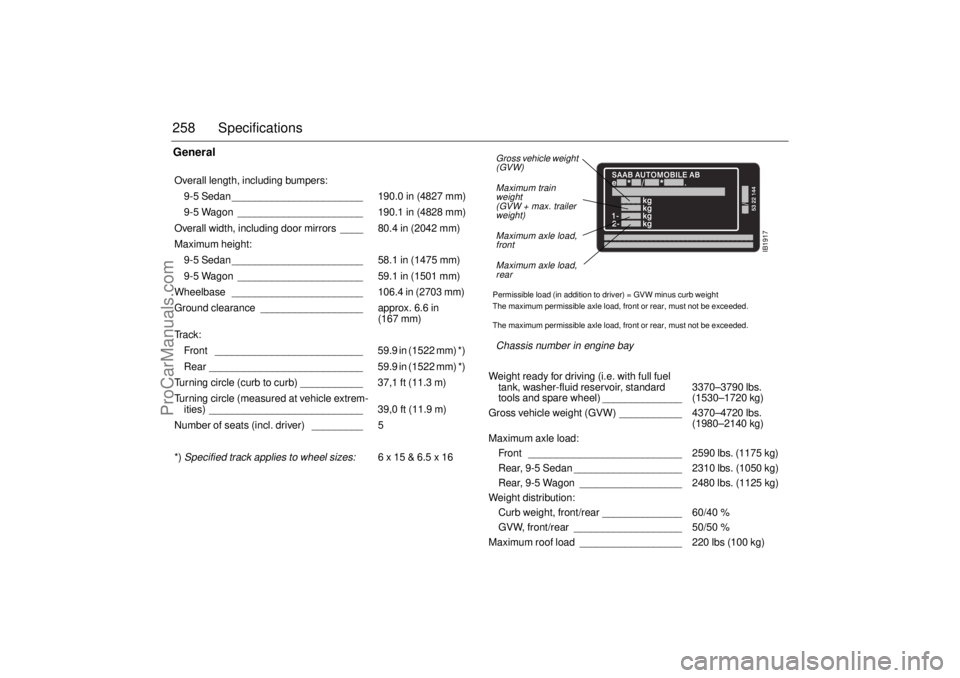
258 SpecificationsGeneral Overall length, including bumpers:
9-5 Sedan _______________________ 190.0 in (4827 mm)
9-5 Wagon ______________________ 190.1 in (4828 mm)
Overall width, including door mirrors ____ 80.4 in (2042 mm)
Maximum height:
9-5 Sedan _______________________ 58.1 in (1475 mm)
9-5 Wagon ______________________ 59.1 in (1501 mm)
Wheelbase _______________________ 106.4 in (2703 mm)
Ground clearance __________________ approx. 6.6 in
(167 mm)
Tr a c k :
Front __________________________ 59.9 in (1522 mm) *)
Rear ___________________________ 59.9 in (1522 mm) *)
Turning circle (curb to curb) ___________ 37,1 ft (11.3 m)
Turning circle (measured at vehicle extrem-
ities) ___________________________ 39,0 ft (11.9 m)
Number of seats (incl. driver) _________ 5
*) Specified track applies to wheel sizes:
6 x 15 & 6.5 x 16
Gross vehicle weight
(GVW)
Maximum train
weight
(GVW + max. trailer
weight)
Maximum axle load,
front
Maximum axle load,
rear Permissible load (in addition to driver) = GVW minus curb weight
The maximum permissible axle load, front or rear, must not be exceeded.
The maximum permissible axle load, front or rear, must not be exceeded. Chassis number in engine bay Weight ready for driving (i.e. with full fuel
tank, washer-fluid reservoir, standard
tools and spare wheel) ______________ 3370–3790 lbs.
(1530–1720 kg)
Gross vehicle weight (GVW) ___________ 4370–4720 lbs.
(1980–2140 kg)
Maximum axle load:
Front ___________________________ 2590 lbs. (1175 kg)
Rear, 9-5 Sedan ___________________ 2310 lbs. (1050 kg)
Rear, 9-5 Wagon __________________ 2480 lbs. (1125 kg)
Weight distribution:
Curb weight, front/rear ______________ 60/40 %
GVW, front/rear ___________________ 50/50 %
Maximum roof load __________________ 220 lbs (100 kg)
IB1917
ProCarManuals.com
Page 274 of 288

274 IndexDoor handles
____________________ 42
Door mirrors ___________________ 125
Doors, locks & luggage compartment
_41
Drive belt
______________________ 263
Drive belt, alternator
_____________ 211
Drive belts, length
_______________ 263
Driver’s seat, programmable
________ 14
Driving at night
_________________ 186
Driving in hot weather
____________ 181
Driving with a load
_______________ 187
EESP
__________________________ 176
Electric heating seat
______________ 15
Electric heating, front seats
_________ 15
Electric windows
________________ 131
Electrical system, technical data
____ 263
Electrically heated rear seat
________ 15
Electronic Stability Program, ESP
___ 176
Electronic starting interlock
_________ 43
Emergency operation of sunroof
____ 133
Emission control systems
_________ 201
Engine bay, 3.0t V6
______________ 200
Engine bay, 4-cyl
_______________ 199
Engine bay, cleaning _____________ 245
Engine number
_________________ 269
Engine oil, grade ________________ 261
Engine, description _________ 202
, 203
Engine, technical data
____________ 260
Engine, temperature gauge
________ 63
Engine-oil level, checking
_________ 203
Expansion tank, coolant
__________ 206
FFault codes, Audio System
________109
Flat spot, tire
___________________241
Fluid level, automatic transmission
__205
Folding the rear seat, 9-5 Sedan
____139
Folding the rear seat, 9-5 Wagon ___142
Frequently asked questions on airbag
39
Front fog lights
__________________74
Frost warning
___________________66
Fuel
__________________________158
Fuel consumption
________________65
Fuel filler door
__________________150
Fuel gauge
_____________________63
Fuel grade _____________________260
Fuse box under hood
____________230
Fuse panel
____________________226
Fuses
________________________226
GGarage door opener
_____________126
Gearbox number
________________269
Gearbox oil, checking
____________205
Gearbox, technical data, __________264
Glove compartment
______________136
HHandbrake
_____________________195
Hazard warning lights
_____________74
Head restraint
___________________16
Headlight flasher _________________71Headlights
_____________________ 71
Holidaying abroad
______________ 248
Hood
________________________ 198
Horn _________________________ 124
IIgnition switch
_________________ 152
Immobilizer
____________________ 43
Indicator and warning lights
________ 56
Indicator lights
__________________ 56
Instrument illumination
___________ 73
Instruments and controls __________ 55
Integral child seat
_______________ 31
Interior equipment ______________ 123
Interior lighting
_________________ 134
Interior rearview mirror
__________ 125
JJack
_________________________ 239
KKey
__________________________ 42
Key to chassis number
__________ 270
Key, remove
__________________ 152
LLATCH (child safety)
_____________ 24
Labels
_________________________ 8
Leather upholstery, care of
_______ 243
Light horn
_____________________ 71
ProCarManuals.com
Page 275 of 288

275 Index
Light switches
___________________ 71
Luggage-compartment lighting
_____ 134
MMain instrument panel
_____________ 56
Main/dipped beam
_______________ 71
Maintenance schedule ___________ 254
Manual gearbox, technical data
____ 264
Maxi fuses
_____________________ 227
Milometer ______________________ 62
Motoring abroad
________________ 248
NNight Panel
_____________________ 69
OOil capacity, engine
______________ 260
Oil change, engine ______________ 204
Oil specification
_________________ 260
OnStar
________________________ 111
Outdoor temperature
______________ 65
Owner assistance
_______________ 255
PPaintwork, touching-in
____________ 245
Parking Assistance
______________ 193
Parking lights
___________________ 71
Plates and labels ________________ 269
Poly-V-belt
____________________ 211
Power steering _________________ 208Power-steering fluid
_____________208
Pressure gauge
__________________64
Programming I, ACC
______________83
Programming II, ACC _____________84
Programming the ACC ____________83
QQuestions on function of airbag
_____39
Quick guide, Audio System
_________91
RRadiator fan
____________________211
Radio
__________________________94
Rain sensor
_____________________75
Rear fog light ____________________72
Rear seat, 9-5 Sedan, folding
______139
Rear seat, 9-5 Wagon, folding _____142
Rear-seat head restraints
__________16
Rear-view mirror, antidazzle _______129
Rearview mirrors
________________125
Reclamation
___________________248
Recommendations for cars with
automatic transmission,
towing a caravan or trailer
________182
Refuelling
_____________________158
Relay panel ____________________229
Remote control __________________42
Remote-control battery, changing
____45
Remove the key
________________152
Reporting safety defects
__________256
Reprogramming of systems _______271Reservoir, power-steering fluid
____ 208
Rev counter
____________________ 62
Reversing lights
_________________ 74
Roof load
_____________________ 185
Running-in ____________________ 178
SSID
__________________________ 65
Saab 9-5 Audio System
___________ 89
Saab Information Display (SID)
_____ 65
Saab Parking Assistance
________ 193
Safety belts
____________________ 17
Safety belts, care of
_____________ 243
Safety-belt pretensioners
_________ 18
Safety-belt reminder
_____________ 17
Seats
_________________________ 12
Securing a load
_________________ 46
Selector lever indication,
automatic transmission
__________ 65
Sentronic, manual mode _________ 167
Service costs
__________________ 255
Service information
_____________ 256
Service intervals
_______________ 254
Service record retention
_________ 255
Settings, seats
__________________ 12
Side airbags
___________________ 36
Signalling, horn ________________ 124
Sliding floor, 9-5 Wagon
_________ 147
Snow chains
__________________ 179
Spare wheel __________________ 236
Spare wheel and tools
___________ 149
Spark plugs
___________________ 263
ProCarManuals.com
Page 276 of 288

276 IndexSpeed rating
___________________ 232
Speedometer _______________ 62
, 63
Starting in cold weather, ACC
_______ 83
Starting in hot weather, ACC _______ 83
Steering wheel adjustment
________ 124
Steering, technical data
__________ 265
Stone-chip damage, repairing
______ 245
Storage compartments
___________ 136
Sun visors
_____________________ 135
Sunroof
_______________________ 132
Suspension
____________________ 265
Suspension, technical data
________ 265
Switches
_______________________ 71
Symbols _______________________ 10
Systems, adjustment
_____________ 271
TTCS OFF
_______________________ 61
Table of fuses
__________________ 228
Tachometer
_____________________ 62
Tailgate, opening
________________ 46
Tank gauge
_____________________ 63
Technical data __________________ 257
Telematics
_____________________ 111
Temperature control, ACC
_________ 79
Temperature gauge, engine ________ 63
Temperature zones, ACC
__________ 79
Textile carpeting
________________ 243
Through-load hatch ______________ 141
Tie Downs
_____________________ 141
Tightening torque, wheel studs
_____ 237
Tip, driving at night
______________ 186Tip, to avoid theft
________________195
Tire markings
_____________ 232
, 233
Tire pressure
______________ 187
, 232
Tires
____________________ 232
, 267
Tires, winter
____________________266
Tools
_________________________149
Touching-in the paintwork
_________245
Towbar attachment
______________181
Towbar load
___________________184
Towing the car __________________189
Towing, automatics
______________189
Traction
_______________________175
Trailer weights
__________________259
Trionic
________________________201
Trip computer
___________________65
Trip meter
______________________62
Trunk
_________________________139
Trunk lid, opening
________________46
Turbo gauge
____________________64
Turbo, points to note
_____________155
UUnder the hood, 3.0t V6
__________200
Under the hood, 4-cyl
____________199
Upholstery and trim
______________243
Upholstery and trim, care of
_______243
Useful tips, ACC
_________________85
VVanity mirrors
__________________135
Ventilated front seats
_____________15
Viscosity, engine oil
______________260
WWarning labels
___________________ 8
Warning light, AIR BAG
___________ 38
Warning lights
__________________ 56
Washers
_____________________ 212
Washers, windshield
____________ 213
Washing the car
_______________ 244
Waxing and polishing
___________ 245
Wear indicators, tires ____________ 234
Wheel, change
________________ 237
Wheels and tires ___________ 232
, 267
Wheels and tires, sizes
__________ 266
Window glass sensor, car alarm
____ 49
Windshield washers
_____________ 75
Windshield wipers
_______________ 75
Winter tires
___________________ 266
Wiper blades, replacing
__________ 212
Wipers and washers
_________ 75
, 212
ProCarManuals.com